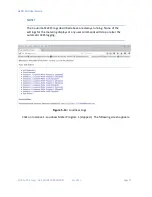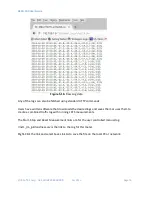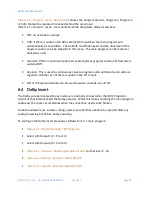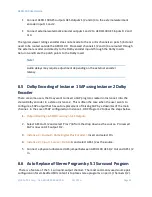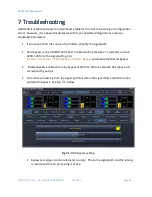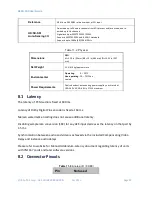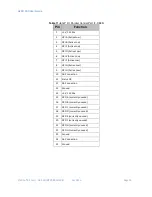
AERO.100 User Guide
©2016 TLS Corp. ALL RIGHTS RESERVED
Oct 2016
Page 86
An Ethernet connection to the AERO.100 that is unstable (i.e. bad port or other network issue)
can cause the same issue as switching unsynchronized sources into the AERO.100. The
Ethernet connection must be stable.
Chattering or other issues with a Dolby encoded source that is connected to an AES-3 input may
be due to the input sample rate converter (SRC) not being in bypass. The SRC setting of found
here:
System > I/O Setup > SRC Bypass.
7.4
7.4
7.4
7.4
Dolby Digital, Dolby Digital Plus or Dolby E output
Dolby Digital, Dolby Digital Plus or Dolby E output
Dolby Digital, Dolby Digital Plus or Dolby E output
Dolby Digital, Dolby Digital Plus or Dolby E output dropouts
dropouts
dropouts
dropouts
When using the internal Dolby Digital (Digital Plus or E) encoder noise in the Dolby encoded
signal is usually caused by not having a proper reference with respect to the DTV video
encoder/multiplexer. All gear should be referenced to the local plant timing. In some cases the
transmission encoder generates a special reference signal that must be routed back to the
AERO.100 and used as its reference. Consult your DTV encoder reference manual for more
details.
7.5
7.5
7.5
7.5
Audio sounds strange
Audio sounds strange
Audio sounds strange
Audio sounds strange
Audio that sounds reverberant, hollow or like sound in a tunnel indicates timing differences
between the audio channels. Stereo viewers are usually the first to notice such problems. The
delay settings in AERO.100 should all be equal, or set explicitly. Offsets of just a few
milliseconds can be audible under the right conditions.
For those using a Dolby DP564 AC-3 decoder, one of the monitoring modes uses the analog and
digital outputs. This can inject up to 10 ms of delay into the surround channels, which usually
elicits complaints. Either bypass the unit or set the monitoring mode to Digital.
7.6
7.6
7.6
7.6
Audio issues disappear in b
Audio issues disappear in b
Audio issues disappear in b
Audio issues disappear in bypass
ypass
ypass
ypass
Since AERO.100 can apply significant gain to incoming signals, previously inaudible sounds may
get pulled out of the background. We recommend listening carefully to the station audio for
hums, buzzes, clicks, pops, phase issues, frequency response problems, bass build-up and other
problems in the source audio. When amplified, these artifacts can ruin otherwise excellent
programming.
Ensure that stereo source material that will be upmixed is very clean and that it is actually
stereo or it may not sound good in surround.
Ensure that input channels 3, 4, 5 and 6 are silent when source programs changes between
stereo and surround. Alternately, use a GPI or command over IP to Mute 3/4 and 5/6.



